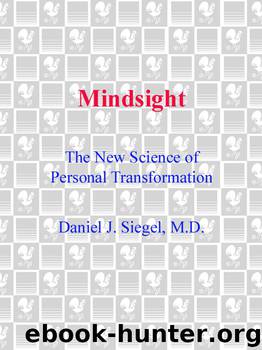Mindsight: The New Science of Personal Transformation by Daniel J. Siegel

Author:Daniel J. Siegel
Language: eng
Format: mobi
ISBN: 9780553907100
Publisher: Random House, Inc.
Published: 2009-11-29T14:00:00+00:00
ENCODING WITHOUT AWARENESS
If you had been a volunteer in one of the classic studies of divided attention, it would have gone something like this: The researcher gives you a set of headphones that play a different soundtrack into each ear and asks you to pay attention to the left side only. After a minute, she asks what you heard. Someone reciting a list of zoo animals, you say. What gender was the voice? Male, you reply. Fine. And what did you hear in the right ear? Just some vague mumblings, you say. And could you tell if it was a male or female voice? No, not even that.
But then the researcher administers what is called an indirect memory test, which reveals that the information from the right earpiece did indeed enter your mind and influence your memory—your implicit memory. You cannot recall that your right ear picked up a woman’s voice reading flower names. But if you are given a set of partial word cues, such as “re,” you are more likely to fill in the blanks with the letters o and s to create rose than any other set of letters, even though you don’t know why. If you had heard a list of food items, it might have just “come to you” to write in i and c for rice. This is priming at work in your language centers.
When your unattended right ear took in the data, your brain registered it in a form of perceptual implicit memory. It does this without passing the information through the hippocampus, the sea horse–shaped cluster of neurons in the limbic region that integrates widely separated areas of the brain. Direct attention harnesses the hippocampus; indirect attention—attention that does not involve your focal, conscious attention—encodes the memory without hippocampal involvement.
Again, an implicit-only memory is experienced in consciousness but is not “tagged” or felt as something emerging from the past. This is quite different from the idea of “unconscious memory,” which implies something buried, inaccessible, or “repressed” and kept from everyday awareness. A reactivated implicit memory is fully conscious; it just lacks the sensation of recall.
This peculiar qualitative experience of implicit memory can be hard to grasp even for neurology students. So let me share a time-honored story about a nineteenth-century neurologist named Clafard and his unfortunate female patient. It seems that Madame X, the patient, could chat about everyday events with her doctor, but if he left the room and returned a few minutes later, she would not recognize him or remember their conversation. He would have to reintroduce himself formally and begin again. One day, Dr. Clafard hid a pin in his hand, so that when he greeted Madame X and shook her hand, she received a sharp prick that caused her to cry out. At their next meeting, Dr. Clafard introduced himself as usual and then extended his hand. Madame X pulled back and refused to shake it. When asked why, she replied, “Sometimes doctors do things that hurt you.”
Here is a mental model based on implicit memory: “Sometimes doctors do things that hurt you.
Download
This site does not store any files on its server. We only index and link to content provided by other sites. Please contact the content providers to delete copyright contents if any and email us, we'll remove relevant links or contents immediately.
The Compound Effect by Darren Hardy(8719)
Wonder by R.J. Palacio(8366)
Atomic Habits: Tiny Changes, Remarkable Results by James Clear(8109)
Becoming Supernatural by Dr. Joe Dispenza(8022)
Wonder by R. J. Palacio(7851)
Change Your Questions, Change Your Life by Marilee Adams(7547)
The Road Less Traveled by M. Scott Peck(7461)
Born to Run: by Christopher McDougall(7012)
Daring Greatly by Brene Brown(6356)
Big Magic: Creative Living Beyond Fear by Elizabeth Gilbert(5541)
Grit by Angela Duckworth(5438)
The Slight Edge by Jeff Olson(5309)
Men In Love by Nancy Friday(5096)
The Wisdom of Sundays by Oprah Winfrey(5041)
You Are a Badass at Making Money by Jen Sincero(4721)
Fear by Osho(4610)
The Four Tendencies by Gretchen Rubin(4504)
The Miracle Morning by Hal Elrod(4485)
Rising Strong by Brene Brown(4329)
